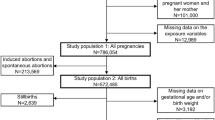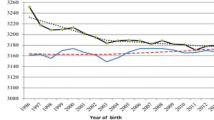Abstract
OBJECTIVE: Educational inequality in stillbirth has been documented in high-income countries and the province of Québec, Canada, but temporal trends are poorly understood. Our objective was to determine time trends in inequality related to maternal education for all-cause and cause-specific stillbirth over the past three decades in Québec.
METHODS: We included 2,397,971 live births and 9,983 stillbirths from 1981 through 2009 using Québec vital statistics. For each decade, we computed measures of inequality capturing relative (relative index of inequality, RII) and absolute (slope index of inequality, SII) differences between the least- and most-educated mothers for all-cause and cause-specific stillbirth, adjusting for maternal characteristics.
RESULTS: Stillbirth rates decreased over time for all education levels. Absolute educational inequality (SII 2.5 per 1000 births, 95% CI 2.1–2.8; all periods combined) was stable over time, whereas relative inequality increased (RII1981–1989 1.8 vs. RII2000–2009 2.3). Absolute inequality decreased for stillbirths caused by placental abruption (SII1981–1989 0.6 vs. SII2000–2009 0.3), but increased for unspecified causes (SII1981–1989 0.2 vs. SII2000–2009 0.7).
CONCLUSIONS: Absolute educational inequality in stillbirth persisted and relative inequality increased over the past three decades, despite an overall decrease in stillbirth rates. The decrease in absolute inequality for placental abruption was countered by an increase for unspecified causes. A better understanding of the underlying components of unspecified causes is needed to further address educational inequality in stillbirth.
Résumé
Objectif: Des inégalités de scolarité maternelle pour les mortinaissances ont été documentées dans plusieurs pays industrialisés, mais leurs tendances temporelles sont moins connues. Notre objectif était d’étudier les tendances temporelles des inégalités de scolarité pour les mortinaissances, toutes causes et par cause, pour les trois dernières décennies au Québec, Canada.
MÉTHODES: Nous avons inclus 2 397 971 naissances vivantes et 9 983 mortinaissances du Québec de 1981 à 2009. Pour chaque décennie, nous avons obtenu un indice d’inégalité relatif (« relative index of inequality», RII) et un indice d’inégalité absolu (« slope index of inequality», SII) pour l’association entre la scolarité maternelle et les mortinaissances, toutes causes et par cause, en ajustant pour les caractéristiques maternelles.
RÉSULTATS: Les taux de mortinaissance ont diminué pour tous les niveaux de scolarité. L’inégalité absolue de scolarité est demeurée stable (SII 2,5 pour 1 000 naissances, intervalle de confiance à 95 % 2,1–2,8; périodes combinées), tandis que l’inégalité relative a augmenté (RII 1,8 à 2,3). L’inégalité absolue a diminué pour les mortinaissances causées par un décollement placentaire (SII 0,6 à 0,3), mais a augmenté pour les causes non-spécifiées (SII 0,2 à 0,7).
CONCLUSIONS: L’inégalité absolue de scolarité pour les mortinaissances a persisté et l’inégalité relative a augmenté au cours des trois dernières décennies, malgré une diminution des taux de mortinaissance. Malgré une diminution de l’inégalité pour les décollements placentaires, on observe une augmentation pour les causes non-spécifiées. Une meilleure compréhension des composantes contribuant à ces dernières est nécessaire pour mieux appréhender les inégalités de scolarité pour les mortinaissances.
Similar content being viewed by others
References
Fretts, RC. The study of stillbirth. Am J Obstet Gynecol 2009;201(5):429–30.
Flenady V, Koopmans L, Middleton P, Froen JF, Smith GC, Gibbons K, et al. Major risk factors for stillbirth in high-income countries: A systematic review and meta-analysis. Lancet 2011;377(9774):1331–40.
Luque-Fernández MÁ, Lone NI, Gutiérrez-Garitano I, Bueno-Cavanillas A. Stillbirth risk by maternal socio-economic status and country of origin: A population-based observational study in Spain, 2007–08. Eur J Public Health 2012;22(4):524–29.
Rom AL, Mortensen LH, Cnattingius S, Arntzen A, Gissler M, Nybo Andersen, AM. A comparative study of educational inequality in the risk of stillbirth in Denmark, Finland, Norway and Sweden 1981–2000. J Epidemiol Community Health 2012;66(3):240–46.
Auger N, Delezire P, Harper S, Platt, RW. Maternal education and stillbirth: Estimating gestational-age-specific and cause-specific associations. Epidemiol 2012;23(2):247–54.
Luo ZC, Wilkins R, Kramer, MS. Effect of neighbourhood income and maternal education on birth outcomes: A population-based study. CMAJ 2006;174(10):1415–20.
Froen JF, Arnestad M, Frey K, Vege A, Saugstad OD, Stray-Pedersen B. Risk factors for sudden intrauterine unexplained death: Epidemiologic characteristics of singleton cases in Oslo, Norway, 1986–1995. Am J Obstet Gynecol 2001;184(4):694–702.
Rasmussen S, Albrechtsen S, Irgens LM, Dalaker K, Maartmann-Moe H, Vlatkovic L, et al. Risk factors for unexplained antepartum fetal death in Norway 1967–1998. Early Hum Dev 2003;71(1):39–52.
Winbo I, Serenius F, Dahlquist G, Kallen B. Maternal risk factors for causespecific stillbirth and neonatal death. Acta Obstet Gynecol Scand 2001;80(3):235–44.
Neasham D, Dolk H, Vrijheid M, Jensen T, Best N. Stillbirth and neonatal mortality due to congenital anomalies: Temporal trends and variation by small area deprivation scores in England and Wales, 1986–96. Paediatr Perinat Epidemiol 2001;15(4):364–73.
Mahony R, Mulcahy C, McAuliffe F, Herlihy CO, Carroll S, Foley, ME. Fetal death in twins. Acta Obstet Gynecol Scand 2011;906(11):1274–80.
Raghunathan, TE. What do we do with missing data? Some options for analysis of incomplete data. Annu Rev Public Health 2004;25:99–117.
Mackenbach JP, Kunst, AE. Measuring the magnitude of socio-economic inequalities in health: An overview of available measures illustrated with two examples from Europe. Soc Sci Med 1997;44(6):757–71.
Wilcox AJ, Weinberg CR, Basso O. On the pitfalls of adjusting for gestational age at birth. Am J Epidemiol 2011;174(9):1062–68.
Borrell C, Cirera E, Ricart M, Pasarin MI, Salvador J. Social inequalities in perinatal mortality in a Southern European city. Eur J Epidemiol 2003;18(1):5–13.
Dummer TJ, Dickinson HO, Pearce MS, Charlton ME, Parker L. Stillbirth risk with social class and deprivation: No evidence for increasing inequality. J Clin Epidemiol 2000;53(2):147–55.
Seaton SE, Field DJ, Draper ES, Manktelow BN, Smith GC, Springett A, et al. Socioeconomic inequalities in the rate of stillbirths by cause: A populationbased study. BMJ Open 2012;2(3):e001100 doi:10.1136/bmjopen-2012-001100.
Ananth CV, Smulian JC, Vintzileos, AM. Incidence of placental abruption in relation to cigarette smoking and hypertensive disorders during pregnancy: A meta-analysis of observational studies. Obstet Gynecol 1999;93(4):622–28.
Gray R, Bonellie SR, Chalmers J, Greer I, Jarvis S, Kurinczuk JJ, et al. Contribution of smoking during pregnancy to inequalities in stillbirth and infant death in Scotland 1994–2003: Retrospective population based study using hospital maternity records. BMJ 2009;339:b3754.
Aubé-Maurice J, Rochette L, Blais C. Relation entre la défavorisation et l’incidence de l’hypertension artérielle chez les individus de 20 ans et plus au Québec en 2006–2007. Québec, QC: Institut national de santé publique du Québec, 2010. Available at: http://www.inspq.qc.ca/pdf/publications/1060_Hypertension20AnsEtPlus2006-2007.pdf (Accessed September 4, 2012).
Lamontagne P, Hamel D. Poids corporel de la population adulte québécoise: Mise à jour 2005 / Exploitation des données de l’ESCC 3.1. Québec: Institut national de santé publique du Québec, 2008. Available at: http://www.inspq.qc.ca/pdf/publications/739_PoidsCorpoPopuAdulteQuebecoise.pdf (Accessed September 4, 2012).
Lasnier B, Leclerc B-S, Hamel D. Les inégalités sociales de santé en matière de tabagisme et d’exposition à la fumée de tabac dans l’environnement au Québec. Québec: Institut national de santé publique du Québec, 2012. Available at: http://www.inspq.qc.ca/pdf/publications/1487_ISSTabagExpo FumeeTabacEnviroQc.pdf (Accessed September 4, 2012).
De Wals P, Tairou F, Van Allen MI, Uh SH, Lowry RB, Sibbald B, et al. Reduction in neural-tube defects after folic acid fortification in Canada. N Engl J Med 2007;357(2):135–42.
Allen VM, Armson BA, Wilson RD, Blight C, Gagnon A, Johnson J-A, et al. Teratogenicity associated with pre-existing and gestational diabetes. J Obstet Gynaecol Can 2007;29(11):927–44.
Hollier LM, Leveno KJ, Kelly MA, McIntire DD, Cunningham, FG. Maternal age and malformations in singleton births. Obstet Gynecol 2000;96(5 Pt 1):701–6.
Demographics and Risk Indicators Working Group (DRIWG), Canadian Congenital Anomalies Surveillance Network (CCASN). Congenital Anomalies Surveillance in Canada: Results of a 2006–2007 Survey on Availability of Selected Data Variables in Canadian Provinces and Territories. Ottawa, ON: Public Health Agency of Canada, 2010. Available at: http://www.phacaspc.gc.ca/ccasn-rcsac/sac-cas/ (Accessed September 4, 2012).
Public Health Agency of Canada. Canadian Perinatal Health Report, 2008 Edition. Ottawa, ON: PHAC, 2008. Available at: http://www.phac-aspc.gc.ca/publicat/2008/cphr-rspc/index-eng.php (Accessed September 4, 2012).
Auger N, Denis G. Late pregnancy abortions: An analysis of Québec stillbirth data, 1981–2006. Int J Public Health 2012;57:443–46.
Flenady V, Middleton P, Smith GC, Duke W, Erwich JJ, Khong TY, et al. Stillbirths: The way forward in high-income countries. Lancet 2011;377(9778):1703–17.
Heaman MI, Green CG, Newburn-Cook CV, Elliott LJ, Helewa, ME. Social inequalities in use of prenatal care in Manitoba. J Obstet Gynaecol Can 2007;29(10):806–16.
Author information
Authors and Affiliations
Corresponding author
Additional information
Acknowledgements: NA was supported by a Chercheur-boursier Junior 1 award from the Fonds de recherche du Québec - Santé.
Conflict of Interest: None to declare.
Rights and permissions
About this article
Cite this article
Savard, N., Auger, N., Park, A.L. et al. Educational Inequality in Stillbirth: Temporal Trends in Québec From 1981 to 2009. Can J Public Health 104, e148–e153 (2013). https://doi.org/10.1007/BF03405679
Received:
Accepted:
Published:
Issue Date:
DOI: https://doi.org/10.1007/BF03405679




